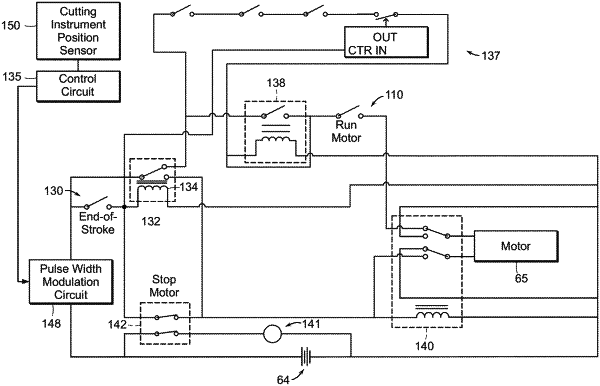| CPC A61B 17/068 (2013.01) [A61B 17/07207 (2013.01); A61B 17/105 (2013.01); A61B 17/32 (2013.01); A61B 17/3205 (2013.01); G16Z 99/00 (2019.02); A61B 2017/00017 (2013.01); A61B 2017/00154 (2013.01); A61B 2017/00398 (2013.01); A61B 2017/00734 (2013.01); A61B 2017/07271 (2013.01); A61B 2017/07278 (2013.01); A61B 2017/07285 (2013.01); A61B 2017/2923 (2013.01); A61B 2017/2927 (2013.01); A61B 2017/320052 (2013.01)] | 6 Claims |

|
1. A surgical instrument for cutting and stapling tissue, wherein the surgical instrument comprises:
a housing;
a shaft extending from the housing;
an end effector extending from the shaft, wherein the end effector is configured to staple and cut tissue, and wherein the end effector comprises:
a proximal end adjacent to the shaft and a distal end spaced from the proximal end; and
a cutting instrument movable along a cutting travel path to cut the tissue, wherein the cutting travel path comprises:
a forward path in which the cutting instrument moves from the proximal end of the end effector toward the distal end; and
a return path in which the cutting instrument moves to the proximal end;
a motor;
a power source for providing electrical energy to the motor;
a cutting instrument position sensor for sensing a position of the cutting instrument along the cutting travel path; and
a motor control circuit connected to the motor and to the power source, wherein the motor control circuit actively controls the current level applied to the motor from the power source so as to control the torque output of the motor based on the position of the cutting instrument along the cutting travel path sensed by the cutting instrument position sensor, such that:
the motor control circuit causes a first current level to be supplied to the motor when the cutting instrument is in a first position range along the forward path of the cutting travel path; and
the motor control circuit causes a second current level, which is different than the first current level, to be supplied to the motor when the cutting instrument is in a second position range along the return path of the cutting travel path;
wherein the motor control circuit is configured to actively control the torque output of the motor whether or not the motor control circuit actively controls the speed of the motor.
|